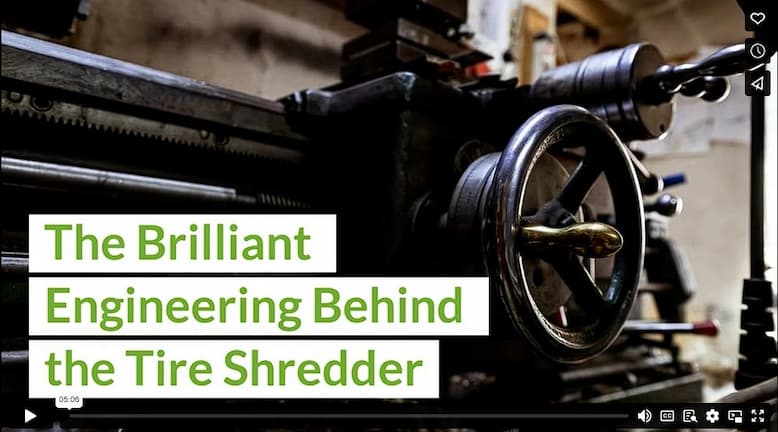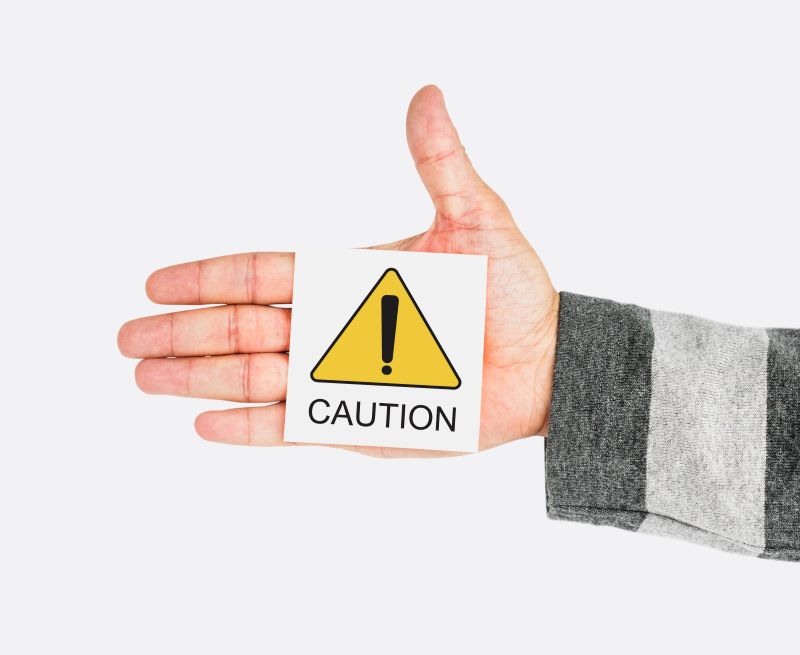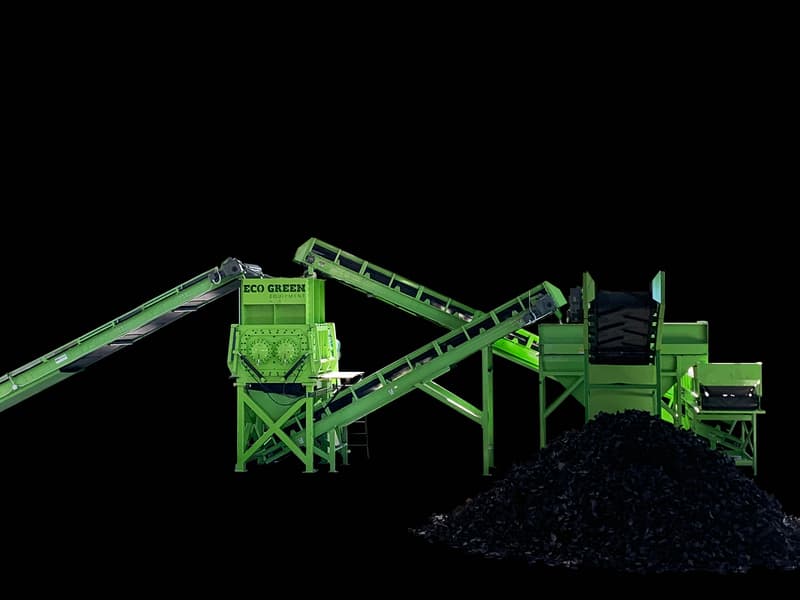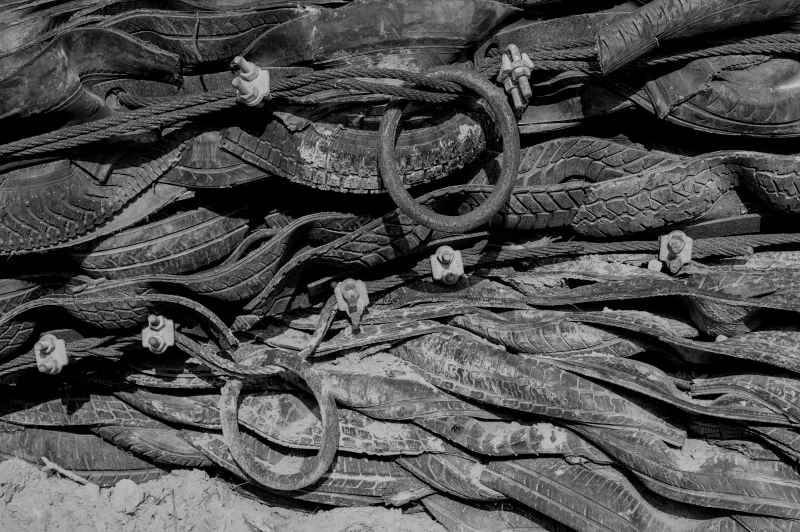The first piece of machinery in all tire recycling lines is the primary shredder. These machines break down large car and truck tires into smaller chunks that can be processed further into a variety of recycling end products. Tire shredders are complex machines. Understanding their basic components and how they work will help you make a better decision when buying a new machine.
How do tire shredders work?
One of the simplest yet most ingenious aspects of tire shredders comes from their efficient use of gravity. Tire shredders can be 20-feet tall. Conveyor belts carry waste tires up to the top of the shredder. From there, the tires drop into the shredder. Two rotating shafts with sharp blades (or teeth) rip the tires apart in the shredding cabinet.
Gravity keeps the tires moving through the system, making the entire process less likely to get jammed or overheat. Using gravity also makes a tire shredder as energy efficient as possible, an essential aspect for many tire recycling companies.
Twin shaft shredders get their name from the two oppositely rotating shafts that use their teeth to tear and shred tires. Twin shaft shredders can also refer to less specialized shredding machines.
What kind of tires can shredders process?
The vast majority of end-of-life tires are of the variety you see daily on passenger cars and 16-wheeler trucks. However, many different types of tires are used in industrial settings.
For example, farmers use tractors and harvesters with massive tires. Manufacturers enlarge these tires to increase traction. The more extensive surface area helps tractors stay on top of muddy ground rather than sinking in. Excavating mines also requires big tires. Mining dump trucks carrying incredibly heavy loads up steep inclines need huge tires and still wear through them faster than almost any other industry.
Generally, specialized mining tire equipment, sometimes called OTR (off the road) shredders, process these extra-large tires. The rubber is thicker and the diameter wider, so especially for the initial stage, an OTR shredder needs to have different dimensions and teeth suitable to tear the extra thick rubber into pieces.
Do shredders need to be maintained?
Yes. Especially the teeth, parallel rotors, and motor. Purchasing new sharp teeth and lubricants are the main costs of maintaining tire shredders. The rest of the frame will need to be kept free of rust and cleaned periodically. Overall, for the amount of work a tire shredder does, it requires little maintenance compared to many assembly line machines and similar industrial equipment.
What is the output of a tire shredder?
Most primary shredders reduce whole tires into tire shreds measuring between five and 15cm. These shreds are then often run through more shredders and tire crushers to achieve a more uniform and clean rubber product. You can sell this product as tire-derived fuel or further recycle it to be used in roads, landscaping projects, playgrounds, and artificial turfs.
Tire shredding aims to convert an awkward, heavy, and common piece of waste, end-of-life tires, into a more versatile rubber product to expand the useful lifespan and reduce the number of tires polluting the environment in landfills and on the side of the road.
Some key things to consider when buying new tire shredding equipment:
● Is the equipment suitable for the kind of tires you plan to recycle? Don’t get an OTR shredder for common car tires. If you are looking to expand your operation, shredders for smaller tires can often be used as secondary shredders for OTR tire recycling.
● Does it come with a conveyor belt to transport tires to the mouth? Many equipment retailers, like ECO Green, sell conveying equipment to move cumbersome tires to the mouth of the primary shredder or from one machine to the next. OTR tires may be too large for conveyor belts and require transportation via a line or pulley system.
● How many tires can it process per hour? For reference, the ECO Giant processes around 45 tons per hour. The amount of tires you can process per unit time is directly correlated to how much profit you can make from a tire recycling line.
● Does the motor have a history of overheating? Overheating can cause significant delays. It’s worth getting a top-end shredder and setting it up in a place with plenty of ventilation to make the most of your tire shredding equipment.
● Is the shredder designed for recycling tires? There are many general shredders on the market, which can help reduce all kinds of different materials, from plastic tubing to wood. Buying a shredder designed explicitly for shredding tires will yield the best results and has fewer chances of becoming clogged.
Final Shreds of Advice
Do your research. Tire shredders are the entry point to getting into the tire recycling business. They are the heavy lifters in the tire recycling process, breaking down the rubber for the successive pieces of machinery. It is worth investing in quality shredding machines engineered to perform efficiently for years. If you have any more questions, please get in touch with the ECO Green Tire Recycling Equipment team to determine which equipment will be best suited for your business.
Infographic
Tires can be recycled, but they must be shredded with a machine that takes a long time to make. Tire shredders carry whole tires and break them into smaller pieces that can be recycled. This cuts down on the amount of trash that ends up in landfills. Tire shredders use compression, shearing, and grinding to reduce tire pieces to consistency.
Video






